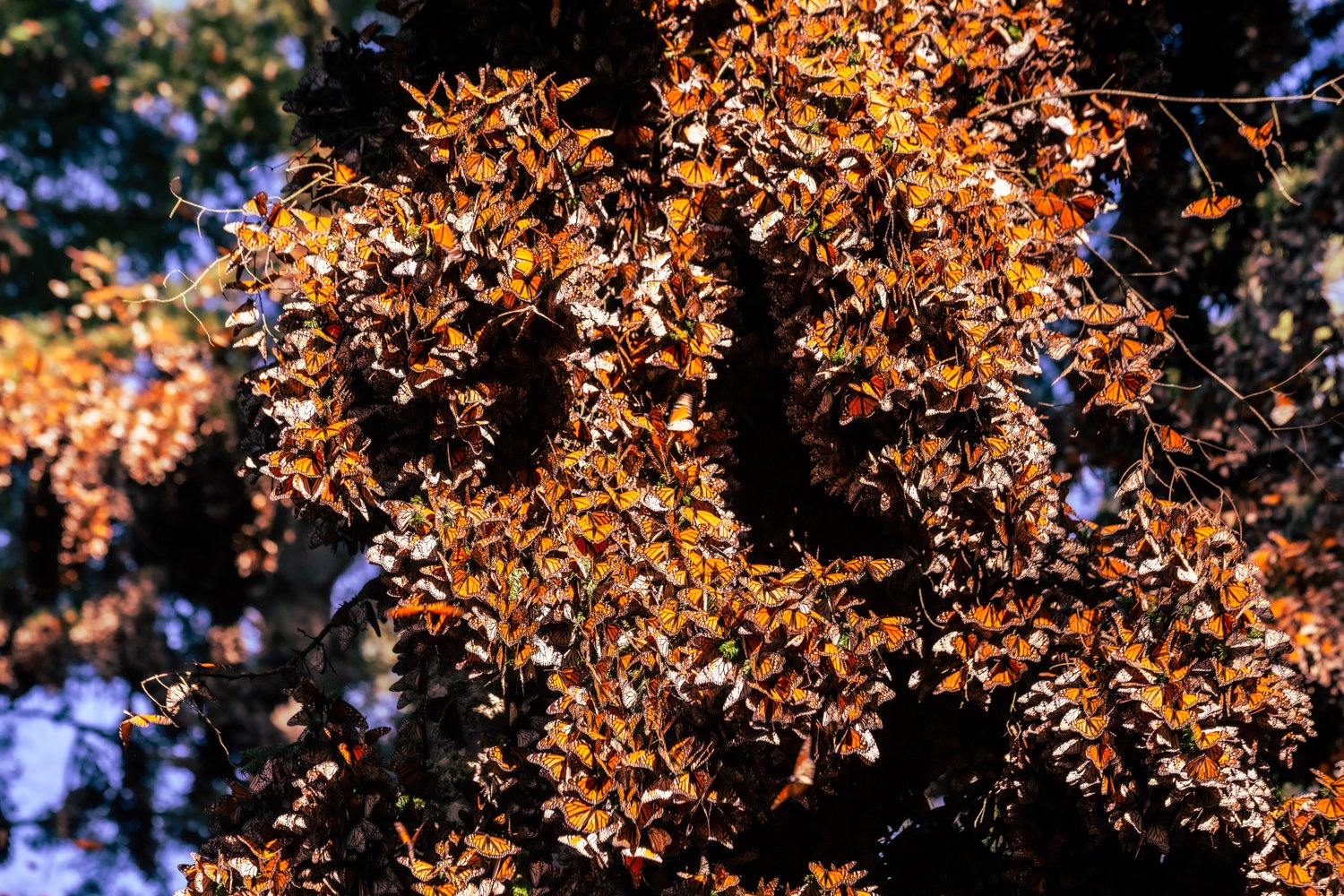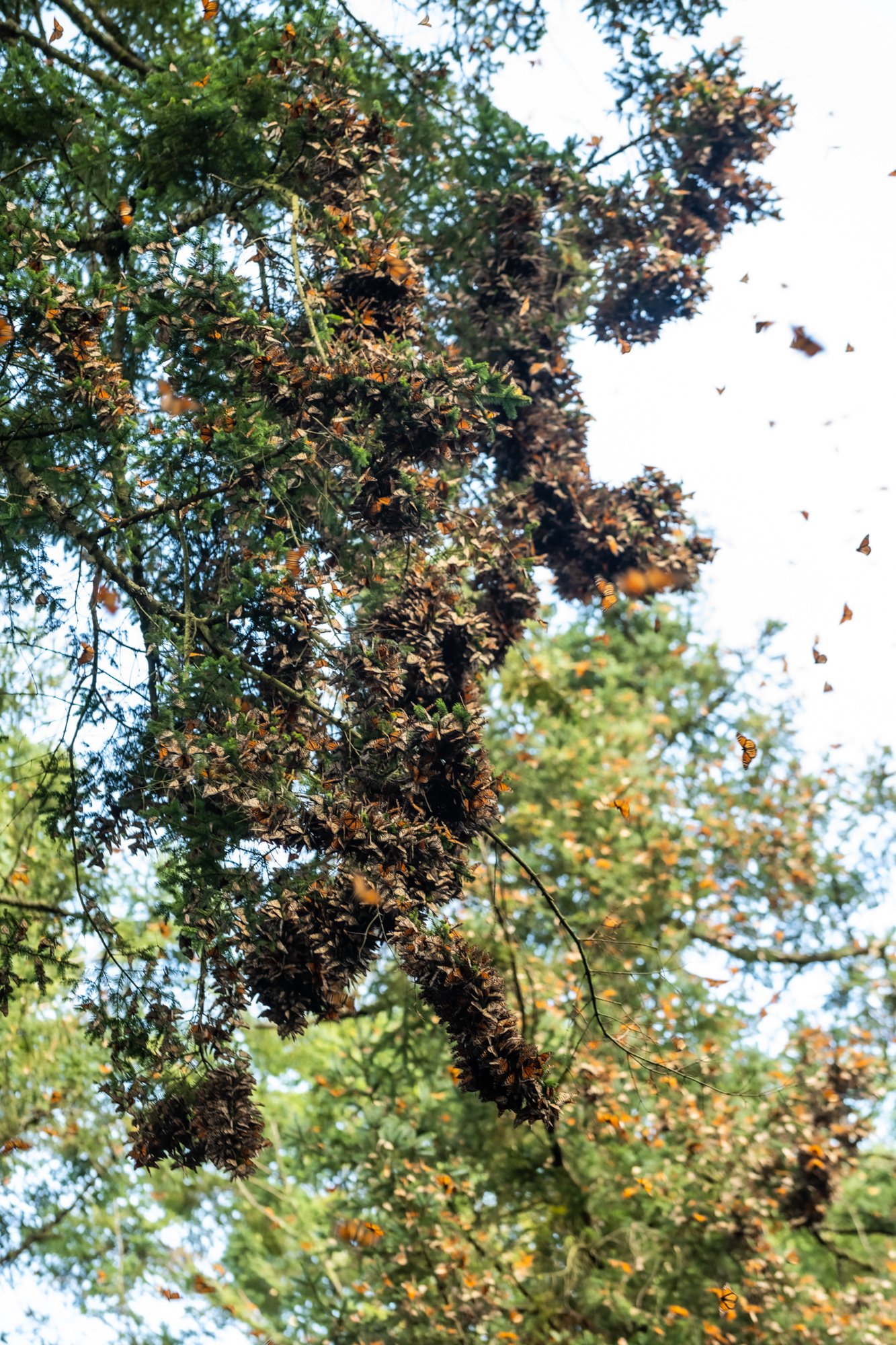Butterfly Effect
Monarch butterflies are now listed as endangered. If observing their migration in Michoacán, bring along these responsible travel tips— and how we can all work to protect them moving forward.
Every November, in the central Mexican state of Michoacán, a flood of black-and-orange wings descends upon the pine, oak, and oyamel fir trees of Central Mexico’s mountain forests.
After their 2,500-mile journey from the eastern U.S. and Canada, the eastern monarch butterflies deservedly rest their tired wings in Mexico’s temperate climate and protected forests for the winter.
The entire journey south can take about two to three months to complete and is considered to be one of the longest migrations of any insect on earth. Making use of both air currents and their fascinating biology, these ‘super monarchs’ are able to make the entire journey to Mexico themselves and still have it within them to enjoy about four or five more months of life in the Mexican mountainscape before breeding the next generation of monarchs. The monarchs that eventually migrate north in the spring live just five to seven weeks, meaning the journey back to the US and Canada can take up to four generations of butterfly to complete.
Experiencing the fairytale-like atmosphere of Michoacán during monarch butterfly season is pure magic. The skies are aswirl with flashes of black-and-orange monarch wings, while the trees are positively dripping (and bending) with millions of butterflies closely huddled together in the branches. Listen closely and you’ll actually hear the collective rustle of their wings as they roost by the thousands.
For the best views of the monarchs in flight, be sure to time your visit to the butterfly reserve for the heat of the day. As the temperatures warm, the monarchs are more likely to take flight, flitting around the forest to mate. If the temperatures are too cold, like during the early morning hours, the monarchs are more likely to be found asleep and in the trees, wings folded and huddled together to keep warm. This too can be an awe-inspiring sight, as their delicately folded wings look just like clumps of dried leaves until you look a little closer and realize that it’s actually thousands of sleeping butterflies.
Visiting the Monarch Butterfly Sanctuary Responsibly
Heartbreakingly, the beloved monarchs have recently become listed as endangered, experiencing a devastating decline of between 85% and 95% since the 1990s. The butterflies are imperiled by loss of habitat and increased use of herbicides and pesticides for agriculture, as well as climate change. This is all part of how parents will have to learn to communicate biodiversity loss to our children, and how to honor and process losing their favorite creatures.
If you and your family do visit the UNESCO-listed reserve, keep these responsible travel tips in mind to ensure your visit is as low impact as possible:
Keep a respectful distance from any trees covered in butterflies and refrain from touching any of the butterflies resting on the trees or flying around.
This one’s common sense, but be sure to throw your trash in the waste bins, not the forest floor.
Stay silent as much as possible while in the reserve and speak in whispers or a low voice when you do speak.
Never stray from the designated paths.
Avoid taking pictures with the flash on, as this can disturb the butterflies.
Help Protect the Monarch Butterfly
Don’t use pesticides in your garden.
Avoid genetically-engineered foods.
Plant native milkweed.
Do biodiversity-focused citizen science projects with your kids.
Make butterfly arts + crafts with your children to honor the species.
Encourage your child to write a letter (or dictate one to you) to your local or federal government officials, asking for their help to protect endangered species.
Create a monarch way station.
Engage in climate change activism with your family and community.
Spread the word.
How To Visit Mexico’s Monarch Butterfly Biosphere Reserve
The Monarch Butterfly Biosphere Reserve extends over about 140,000 acres and across two Mexican states– Michoacán and Estado de Mexico. For purposes of butterfly and wildlife protection, not all of the 140,000 acres of the reserve are open to the public, however both states have three zones that are publicly accessible.
In Michoacán, the most popular public zone to visit is called El Rosario (close to the town of Angangueo), but you can also visit Sierra Chincua and Senguio. In Estado de Mexico, the most popular sanctuary is Piedra Herrada (close to the town of Valle de Bravo), but you can also visit the sanctuaries at El Capulín and La Mesa.
No matter which part of the reserve you visit, be prepared for a relatively steep, but short, path to the location of the butterflies. This means sturdy walking shoes and some water is a good idea to bring with you inside the reserve.
The butterfly reserves of Michoacán are open daily from mid-November through March, with January and February being peak viewing season. Weekends are also quite busy. Upon arrival, you’ll be charged a small entrance fee and will have the option to hire a guide if you’d like some insider information about the butterflies and their impressive migration.









